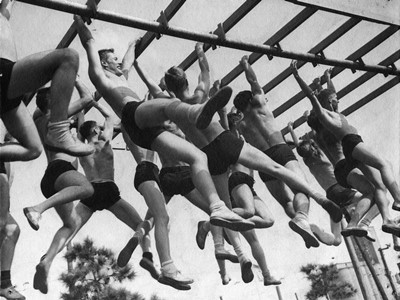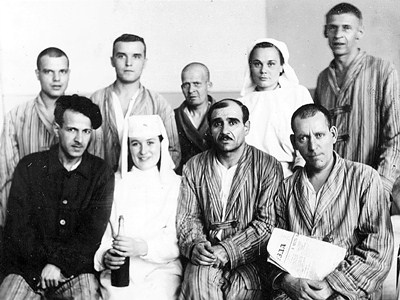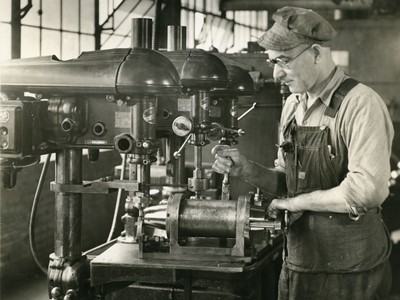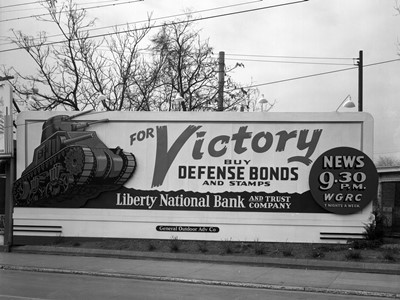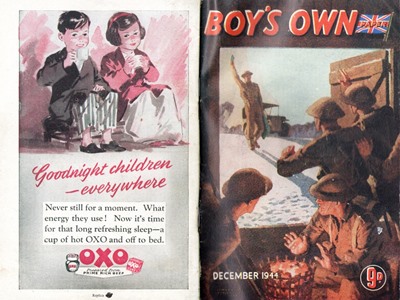Molotov (Perm) during the World War II
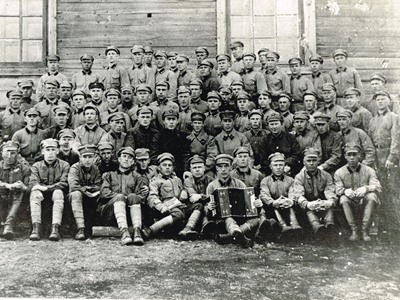 Despite the fact that no fighting took place in the city of Molotov (the name of the city of Perm from 1940 till 1957), the city did not avoid the hardships of wartime. Tens of thousands of Perm residents joined the Red Army, many of whom died or were listed as missing. Dozens of organisations, hundreds of thousands of people, and many cultural institutions were evacuated to the city from areas occupied by enemy forces. Hospitals were opened for wounded soldiers in the city, and residents of Molotov performed a labour feat daily.
Despite the fact that no fighting took place in the city of Molotov (the name of the city of Perm from 1940 till 1957), the city did not avoid the hardships of wartime. Tens of thousands of Perm residents joined the Red Army, many of whom died or were listed as missing. Dozens of organisations, hundreds of thousands of people, and many cultural institutions were evacuated to the city from areas occupied by enemy forces. Hospitals were opened for wounded soldiers in the city, and residents of Molotov performed a labour feat daily.
Conscription, Volunteers
104,000 people were called up from the city of Molotov. Of these, 22,000 died on the battlefields, and 7,000 were missing. Besides, about 50,000 Perm citizens joined the Army as volunteers.
In 1941-1942, 6 rifle divisions, 2 motorized rifle brigades, 2 air force regiments and 2 separate armored train battalions were formed in the city of Molotov and the Molotov Region.
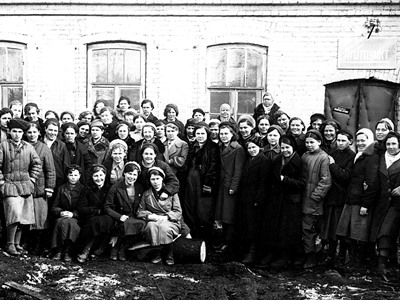 In February 1943, the formation of the Urals Volunteer Tank Corps began. The factory workers of Molotov and the town of Kungur formed the Molotov Tank Brigade, which became part of the Urals Volunteer Tank Corps.
In February 1943, the formation of the Urals Volunteer Tank Corps began. The factory workers of Molotov and the town of Kungur formed the Molotov Tank Brigade, which became part of the Urals Volunteer Tank Corps.
During the war, women were called up for air defense and work for the Red Cross. Apart from conscription, girls and women joined the Army as volunteers. In the first month of the war, more than 10,000 girls of the Molotov region filed applications to join the Army. On April 14, 1942, a train with 2,500 women soldiers went to the front.
Hospitals and Medical Staff
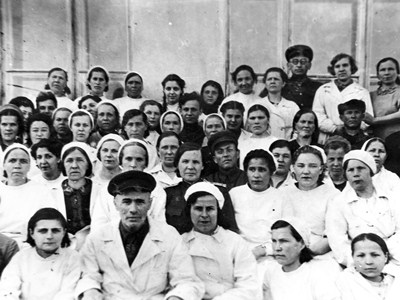 From the very beginning of the war, wounded Red Army soldiers were transported to Molotov. On October 8, 1941, the All-Union Committee for sick and wounded soldiers was established in the USSR. Its branches worked in the Molotov region as well. During the war years, 137 military hospitals were opened in the Molotov Region, 28 of them in the city of Molotov. In addition, battalions of recovering soldiers operated in the city of Molotov. The Second Clinic and the City Psychiatric Hospital were refurbished to accommodate the wounded. Two surgical field mobile hospitals were formed and sent to the Army.
From the very beginning of the war, wounded Red Army soldiers were transported to Molotov. On October 8, 1941, the All-Union Committee for sick and wounded soldiers was established in the USSR. Its branches worked in the Molotov region as well. During the war years, 137 military hospitals were opened in the Molotov Region, 28 of them in the city of Molotov. In addition, battalions of recovering soldiers operated in the city of Molotov. The Second Clinic and the City Psychiatric Hospital were refurbished to accommodate the wounded. Two surgical field mobile hospitals were formed and sent to the Army.
Evacuation hospitals were organised in the buildings of city schools, the Molotov Aviation College, the Molotov Teacher-Training Institute, the Molotov Medical Institute, as well as in the buildings of city hospitals. Some evacuation hospitals after the war were transformed into special hospitals for veterans of the War.
Youth and trade union organizations took the hospitals under their special patronage. Ordinary residents of Molotov became donors. During the war years, residents of the Molotov region donated 24,000 liters of blood.
Plants and factories in the Rear
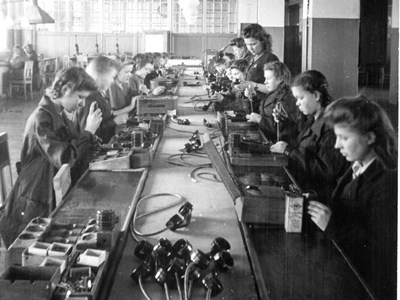 With the outbreak of war and the occupation of the western part of the country, enterprises of the Urals area became the basis of the defence industry. During the war, they produced 40% of industrial output. On June 24, 1941, the Evacuation Council was set up, and the evacuation of manufacturing industries began. In total, Molotov received 64 factories.
With the outbreak of war and the occupation of the western part of the country, enterprises of the Urals area became the basis of the defence industry. During the war, they produced 40% of industrial output. On June 24, 1941, the Evacuation Council was set up, and the evacuation of manufacturing industries began. In total, Molotov received 64 factories.
In December 1941, gramophone factory No. 260 was evacuated from the Vladimir region. Evacuees built workshops and houses. In March 1942, the gramophone factory began producing fuses for artillery shells. The evacuated Leningrad Electrotechnical Plant produced telephones for the front.
Existing Molotov plants started using the capacities of the evacuated factories to concentrate on the production of military equipment.
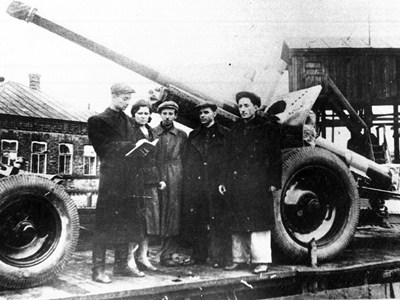 In 1941 the Molotov Plant No. 172 began producing light 45-caliber guns. In total, the plant produced over 48,000 artillery systems of various calibers during the war years (about 25% of all produced in the USSR).
In 1941 the Molotov Plant No. 172 began producing light 45-caliber guns. In total, the plant produced over 48,000 artillery systems of various calibers during the war years (about 25% of all produced in the USSR).
On the eve of the war, the chief designer of the Stalin Plant No. 19 Arkadiy Shvetsov developed a two-row system of aircraft engines M-82 (later - ASh-82). During the war years, the Stalin Plant No. 19 produced 30,000 engines - 15% of all produced at enterprises of the USSR.
The Dzerzhinsky Plant produced ammunition. The Shipyard No. 344 produced armored boats. The Kirov Plant No. 98 produced rocket powder, explosives for Katyusha rocket launchers and aircraft missiles. During the war years, two-thirds of the missile propellants produced in the USSR were made at the plant.
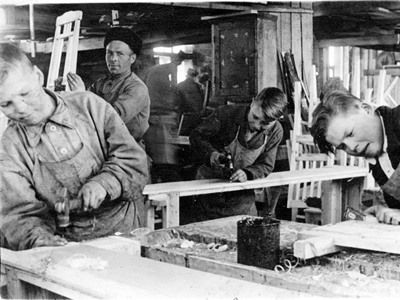 In August 1941, the Krasny Oktyabr Timber Plant was tasked with setting up production of six-seater snowmobiles. The Molotov Plant was one of the six enterprises of the USSR where snowmobiles were produced. In total, the Krasny Oktyabr Plant manufactured 300 snowmobiles. Perm snowmobiles took part in the battles near Stalingrad.
In August 1941, the Krasny Oktyabr Timber Plant was tasked with setting up production of six-seater snowmobiles. The Molotov Plant was one of the six enterprises of the USSR where snowmobiles were produced. In total, the Krasny Oktyabr Plant manufactured 300 snowmobiles. Perm snowmobiles took part in the battles near Stalingrad.
During the war years, the enterprises of Molotov were awarded with 11 Orders - the highest state awards, 3 of those were awarded to the Molotov Plant No. 172.
Outreach Activities
Propaganda departments functioned through the Communist Party authorities at city and city district levels. Employees of these departments gave lectures on the military history of Russia, for example, about the Patriotic War of 1812 or the national hero Aleksandr Suvorov.
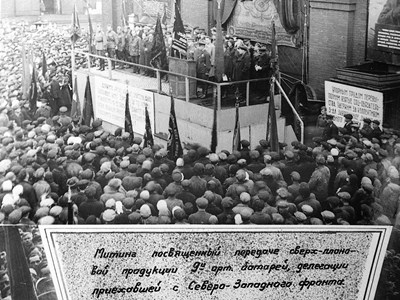 Rallies and meetings publicized local activities such as the launch of new products for the army, or problems in lagging areas of production. After the rallies, warm clothes and bonds were collected for the needs of the USSR Defense Fund. Workers were encouraged to make decisions about transferring a day’s wage to the USSR Defense Fund.
Rallies and meetings publicized local activities such as the launch of new products for the army, or problems in lagging areas of production. After the rallies, warm clothes and bonds were collected for the needs of the USSR Defense Fund. Workers were encouraged to make decisions about transferring a day’s wage to the USSR Defense Fund.
Members of youth organizations of factories created campaign groups and worked in dormitories. The factories administrations had instructors in charge of this area.
An encouragement for women were speeches of leading workers, leaders of women's teams. Women's rallies were held, as well as women's meetings at city, district or quarter levels.
Posters and slogans were widely used, celebrating the work of an individual worker, brigade or shift. Rhymed slogans were in use. The slogans spoke of the importance of workers' labour for the front. Slogans reminded the workers that their comrades risked their lives on the front lines.
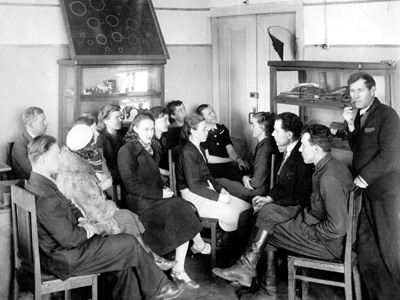 Factories and canteens were equipped with local radio broadcasting units. They reported daily (in special cases every hour) on the work of the staff. Honoured workers talked about their experiences, shared useful skills with colleagues. Radio meetings were held. Sometimes activists were present near the radio speakers to help clarify and interpret the information.
Factories and canteens were equipped with local radio broadcasting units. They reported daily (in special cases every hour) on the work of the staff. Honoured workers talked about their experiences, shared useful skills with colleagues. Radio meetings were held. Sometimes activists were present near the radio speakers to help clarify and interpret the information.
The residents of Molotov learned about the state of affairs at the front from the radio news. Radio speakers were placed at crossroads. Citywide rallies and readings of official Sovinformburo messages were held.
From 1943, the Soviet leadership began official cooperation with religious organizations. The Council for the Affairs of the Russian Orthodox Church was established. Authorized councils acted in the regions, including the Molotov region.
Everyday Life
The population of the Molotov region counted 2,180,000 inhabitants including 255,000 residents in the city of Molotov (Census 1939). Apart from industries, during the war years about 320,000 people were evacuated from the occupied territories to the Molotov region. The Kirov Opera and Ballet Theatre together with a ballet school arrived from Leningrad (now St. Petersburg), as well as Soviet writers and musicians Authors Veniamin Kaverin, Yuriy Tynyanov, Vera Panova, composers Aram Khachaturian, Sergei Prokofiev and others. Canvasses from the Russian Art Museum (Leningrad) were stored and displayed in the Molotov Art Gallery.
Evacuation led to a change in living conditions. Evacuees were settled in apartments shared with other people. If the “sharedness” was not enough to accommodate the evacuees, temporary building such as huts and dugouts were quickly constructed. If a family got a room in a shared apartment they considered themselves lucky. Evacuees were employed at the Molotov armament factories.
The government provided residents through a ration card system. Children and teenagers got additional bread portions at school.
The factories had subsidiary farms. Residents of Molotov were also allocated land for personal use. People exchanged household items for food, sold handicrafts, picked mushrooms and berries, fished and hunted.
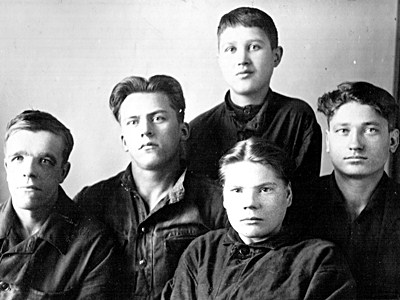 Students took on adult responsibilities while older people worked. Pioneer and Komsomol groups volunteered to help those in need. Many high school students went to work in factories. In 1943, evening schools were established for them. During the war years, the number of vocational, railway colleges, and factory schools grew two-and-a half times. University and institutes continued to operate. From 9am to 2p.m., students studied, and from 6p.m. until 2a.m. they worked in the factories.
Students took on adult responsibilities while older people worked. Pioneer and Komsomol groups volunteered to help those in need. Many high school students went to work in factories. In 1943, evening schools were established for them. During the war years, the number of vocational, railway colleges, and factory schools grew two-and-a half times. University and institutes continued to operate. From 9am to 2p.m., students studied, and from 6p.m. until 2a.m. they worked in the factories.
For young people and children there was entertainment. Dances were held in the river station. Sport competitions were organized for schoolchildren. In 1942, separate training was introduced for boys and girls, but all students had marching and rifle drill.
In September 1941, the Kirov Opera and Ballet Theatre opened in Molotov and from November every night was a full house. Actors combined performing in the theatre with public work. /p>
Newspapers and Magazines
During the war years, newspapers continued to be published in Molotov. The oldest newspaper in the city – Zvezda (The Star) - described daily life in Molotov, interviewed workers of factories, and described the cultural life of the city.
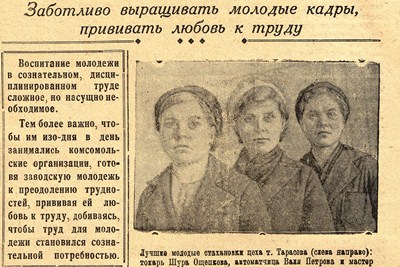 Workers read factory newsletters such as "Molotovsky Worker"- newspaper of the Stalin Plant No. 19. Those were the newspapers whose correspondents were the workers themselves. During 1941-1944 there were published 1401 issues of the Dzerzhinets newsletter.
Workers read factory newsletters such as "Molotovsky Worker"- newspaper of the Stalin Plant No. 19. Those were the newspapers whose correspondents were the workers themselves. During 1941-1944 there were published 1401 issues of the Dzerzhinets newsletter.
The enterprises produced wall newspapers. As a rule, they were issued 1-2 times per month. If it was difficult for workers to read the wall newspaper due to the schedule or remoteness of the workshop, its material was reprinted and sent to the workshop.
The Soviet Union could survive in the war and defeat the enemy thanks to the unity of the front and rear. Molotov became the personification of the city in the rear, which made an invaluable contribution to the great Victory.
Displays
How did we win together?
